九年级英语Unit13第1课时教案
- 格式:docx
- 大小:20.99 KB
- 文档页数:4
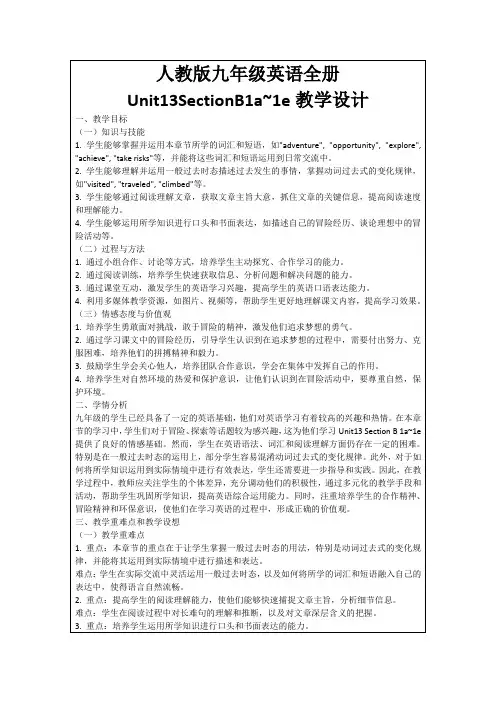
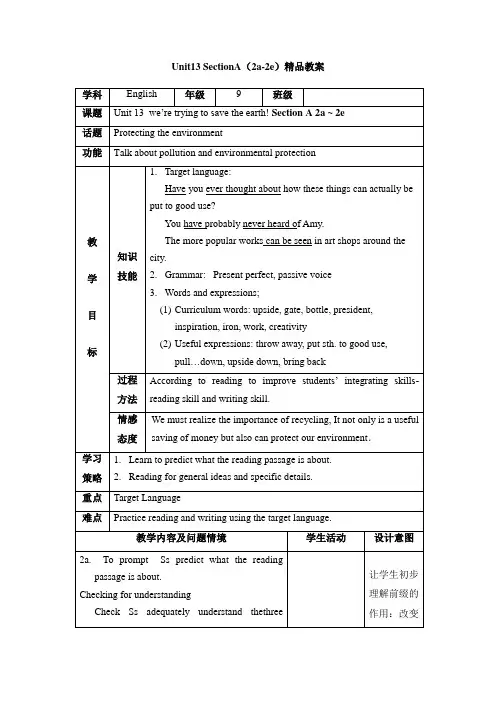
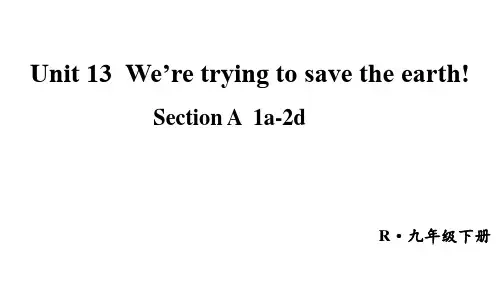
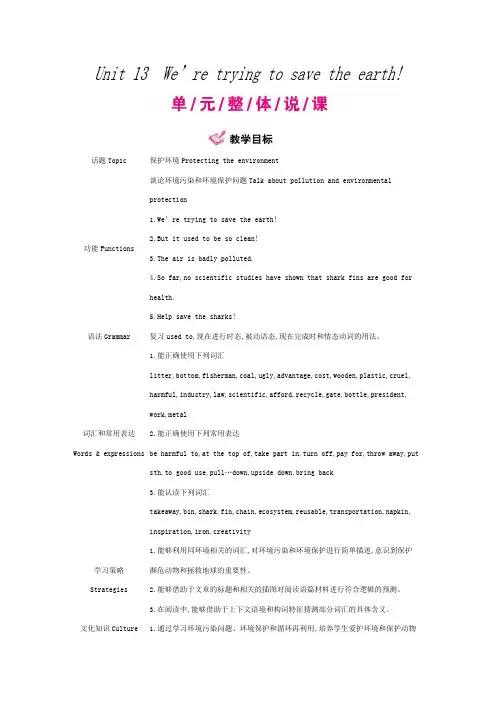
Unit 13 We’re trying to save the earth!话题Topic 保护环境Protecting the environment功能Functions谈论环境污染和环境保护问题Talk about pollution and environmentalprotection1.We’re trying to save the earth!2.But it used to be so clean!3.The air is badly polluted.4.So far,no scientific studies have shown that shark fins are good forhealth.5.Help save the sharks!语法Grammar 复习used to,现在进行时态,被动语态,现在完成时和情态动词的用法。
词汇和常用表达 Words & expressions 1.能正确使用下列词汇litter,bottom,fisherman,coal,ugly,advantage,cost,wooden,plastic,cruel,harmful,industry,law,scientific,afford,recycle,gate,bottle,president,work,metal2.能正确使用下列常用表达be harmful to,at the top of,take part in,turn off,pay for,throw away,putsth.to good use,pull …down,upside down,bring back3.能认读下列词汇takeaway,bin,shark,fin,chain,ecosystem,reusable,transportation,napkin,inspiration,iron,creativity学习策略Strategies 1.能够利用同环境相关的词汇,对环境污染和环境保护进行简单描述,意识到保护濒危动物和拯救地球的重要性。
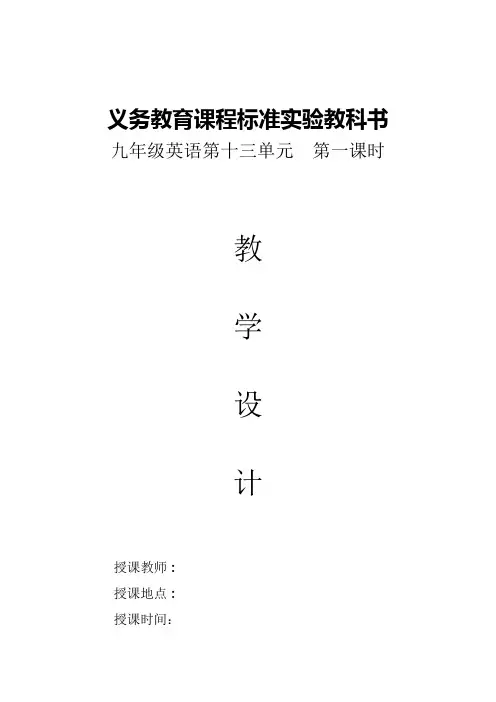
义务教育课程标准实验教科书九年级英语第十三单元第一课时教学设计授课教师:授课地点:授课时间:Unit 13Rainy days make me sadTeaching hours: 1 PeriodPeriod: The first periodⅠ. Chapter content: Section A(1a—1b)Ⅱ. Analysis of the Teaching Material:In this unit, the language aims are to talk about how things affect you and how to express their thoughts about likes or dislikes.Language structure: make sb /sth + adj /doⅢ. Analysis of the students:The students have learned the structure: make sb /sth + adj /do. So this class we will mainly teach the adjectives and to talk how things affect you and how to express their thoughts about likes and dislikes while teaching the structure.Ⅳ. Teaching aims and demands:1. Target language: How do you feel about loud music?Loud music makes me tense. Loud music makes me want to dance.That movie made me sad. Waiting for her made me angry.2. Language structure: make sb /sth +adj Make sb /sth +do3. Ability objectives(1) Train students’ lis tening ability.(2) Trai n students’ speaking ability.(3) Train stude nts’ the ability of using grammar fo cus .Ⅴ. Teaching key points: make sb /sth + adj /doⅥ. Teaching difficult points:1. The target language2. How to train the students’ listening ability.Ⅶ. Teaching methods and learning methods:1. Listening method to improve students’ listening ability.2. Pairwork to make every student work in class.3. Task-based teaching method.Ⅷ. Teaching tools: a computer ,picturesⅨ. Teaching proceduresStep one : Warm-up1. Ask a student: What is your hobby? S: I like reading.T: Why? S: Because it is interesting.T: So it makes you interested.Write down on the blackboard: It makes you interested.2. Ask the other students, get them to say the word :Happy, sad ,excited ,relaxed ,nervous,sick ,energetic ,stressed out, tense comfortable …3. Write these words down and get the students to read the words together.Step two: Presentation1. Using the computer to show some pictures, such as an exciting basketball match, a relaxing scenery, a scary snake, an angry face , a comfortable bedroom and so on .T: How do you feel about Picture 1? Happy? Beautiful? Excited ?Awful ?S: Excited…T: It makes me excited …Show this sentence on the blackboard. Then repeat with the other pictures, get them to say :It makes me happy .It makes me awful ……Step three: Pair workShow some adjectives and phrases on the screen. Let students make up conversations in pairs. For example:A: What makes you sad?B: Rainy days make me sad.Step four: listening practice1. Say: Look at the pictures in 1a.There are two restaurants .Please describe them. For example:In Rockin’ Restaurant ,the paintings on the walls are ugly. The music is too loud . The Blue Lagoon has blue walls , plants , flowers , and a piano player .Let the students say some sentences about the two pictures.Then ask students: Which restaurant would you like to go to ?Why ? Let them use the structur : make sb/sth +adj to say . For example:T: I don’t like The Rockin’ Restaurant, because the loud music makes me tense /comfortable……Then check several students to answer.2. T: Look at the girls in the picture in 1a.They are Amy and Tina. They are hungry, They want to get something to eat. What do they think of the two restaurants? Look at 1b ,read the sentences, you will hear the missing words on the tape, fill in the blanks with the words you hear on the tape . Play the tape the first time , students only listen.Play the tape the second time. and say,This time please fill in the missing words.Check the answers.Play the tape again, let them read the conversation.Step five: listening practiceDo the same as step four.First talk about the pictures in 2a.Then finish the listening task in 2a and 2b.Check the answers with the students.Step six: grammar focusLook at the grammar box. Invite a student to read the sentences tothe class.Then let students make sentences with make sb /sth + adj /do.Using the form on the screen to talk how different weather affect the students feeling.Step seven: summaryIn this class, we’ve learnt key vocabulary and the target language loud music makes me tense,loud music makes me want to dance, that movie made me sad.Step eight : Homework :Finish the dialogue on the screen.Make a dialogue .Ask your friend where he or she would like to go to eat and play . Explain the reason using the structure :make sb / sth +adj /do.Design on the blackboard.Unit 13 Rainy days make me sad.Section A(1a—1c)make sb /sth +adj adjectivesIt makes you interested . happy sad excited relaxed nervous sickIt makes me excited. comfortable stressed tense energetic。
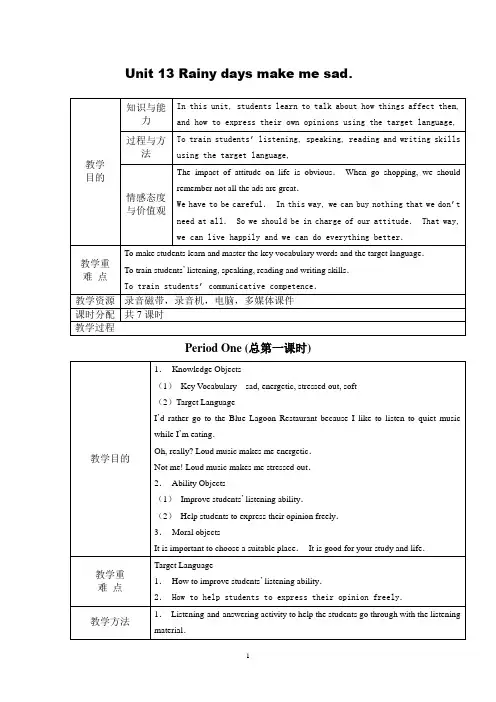
Unit 13 Rainy days make me sad.教学目的知识与能力In this unit, students learn to talk about how things affect them,and how to express their own opinions using the target language, 过程与方法To train students’ listening, speaking, reading and writing skillsusing the target language,情感态度与价值观The impact of attitude on life is obvious.When go shopping, we shouldremember not all the ads are great.We have to be careful. In this way, we can buy nothing that we don’tneed at all. So we should be in charge of our attitude. That way,we can live happily and we can do everything better.教学重难点To make students learn and master the key vocabulary words and the target language.To train students’ listening, speaking, reading and writing skills.To train students’ communicative competence.教学资源录音磁带,录音机,电脑,多媒体课件课时分配共7课时教学过程Period One (总第一课时)教学目的1.Knowledge Objects(1)Key V ocabulary sad, energetic, stressed out, soft(2)Target LanguageI’d rather go to the Blue Lagoon Restaurant because I like to listen to quiet music while I’m eating.Oh, really? Loud music makes me energetic.Not me! Loud music makes me stressed out.2.Ability Objects(1)Improve students’ listening ability.(2)Help students to express their opinion freely.3.Moral objectsIt is important to choose a suitable place.It is good for your study and life.教学重难点Target Language1.How to improve students’ listening ability.2. How to help students to express their opinion freely.教学方法1.Listening-and-answering activity to help the students go through with the listening material.2. Pairwork to make every student work in class 学法指导Helping each other is very important.It is a good quality.教学过程随堂记录Step 1. RevisionYesterday we finished Unit 12.In this unit, we learned how to tell what we are supposed to do.Now tell me some things that are good to do in school and that are not good to do in school.S1: We’re supposed to do our homework every day.S2: We’re supposed to raise our hands before we talk.S3: We’re supposed to come to class on time.S4: We are not supposed to be late for class.S5: We’re not supposed to eat in class.T: Very good.You’re right.From now on, we’ll learn Unit 13.Look at the following list of activities on the blackboard: parties, exams, school vacations, gym class.How do you feel about parties? Happy? Excited? Nervous?Step 2. 1aThis activity introduces new vocabulary and provides oral practice using the target language.Go through the instructions and look at the two pictures.Ask, Who can describe the interior of each restaurant? Let students work in pairs, and tell each other which restaurant they would like to go to and why.When students work, go around the classroom offering help as needed.When they have finished talking to each other, call out several pairs to say their conversations to the class.Step 3. 1bThis activity gives students practice in understanding the target language in spoken conversation.Ask students to read the instructions.Step 4. 1cThis activity provides guided oral practice using the target language.Look at the example in the box.Invite a pair of students to read it to the class.Tell students they will be talking about their own opinions with a partner.Look back at the chart in Activity 16.Make up a conversation with a partner using words from the chart, such as awful pictures, loud music and soft music.Step 5. HomeworkReview the target languagePeriod Two(总第二课时)教学目的1.Knowledge Objects(1)Key V ocabulary tense, have fun, angry, cry.(2)Target Language Loud music makes me tense.Loud music makes me want to dance.That movie made me sad.2.Ability Objects(1)Train students’ listening ability.(2)Train students’ speaking ability.3.Moral ObjectsEnjoying yourself is very important.But no matter what hobbies you have, do remember they must be good for health and study.教学重难点Teaching Key Points1.Key V ocabulary tense, angry, cry.2.Target LanguageLoud music makes me tense.Loud music makes me want to dance.That movie made me sad.3.StructuresLoud music makes me tense.Loud music makes me want to dance.Ⅲ.Teaching Difficult Points1.The target language 2. How to train students’ listening ability.教学方法1.Listening method to improve the students’ listening ability.2. Pairwork.学法指导教学过程随堂记录Step 1. RevisionCheck homework.Invite a pair of students to read the conversation inStep 2. 2aThis activity gives students practice in understanding the target language in spoken conversation.Look at the pictures.Ask, What are they doing? Please guess.Step 3. 2bThis activity provides guided listening practice using the target language.Go through the instructions and point to the list of statements.You will hear the same recording again.This time listen carefully to what each person says.Put a checkmark in front of the statements you hear.Step 4 2cThis activity provides oral practice using the target language.Look at the sample conversation betweenTina and John.Invite a pair of students to read it to the class.John: Did you have fun with Amy last night?Tina: Well…yes and no.She was really late.Go through the instructions with the class.Get students to make up a conversation using information from Activities 2a and 2b.Let students work in pairs.Step 5. HomeworkGet students to write some sentences according to the target language.In this class, we’ve learned key vocabulary tense and the target language Loud music makes me tense.Loud music makes me want to dance.That movie made me sad.Period Three (总第三课时)教学目的1.Knowledge Objects(1)Key V ocabularyowner, scientific, pink, knowledge, serve, uncomfortable, endangered.(2)Target Language How do you feel about pollution?It makes me kind of angry.How about you?It makes me want to join a clean-up campaign.2.Ability Objects(1)Train students’ integrating skills.(2)Train the ability of expressing students’ own opinions.3.Moral ObjectIn our lives, we should express what we feel clearly.教学重难点Train students’ integrating skills.How to improve students’ integrating skills.教学方法1.Fast-reading method.2.Groupwork and pairwork.学法指导教学过程随堂记录Step 1. RevisionT: Yesterday we learned the target language.The structure is…makesme…Now who can make sentences using the structure? S1: Light colours make me relaxed.S2: Loud noise makes me tense.S3: Loud music makes me energetic.T: Very good.Step2. 3aRead the words and get students to repeat again and again until they can pronounce the words fluently and accurately.This activity provides reading and writing practice using the target language.Show the key vocabulary words on the screen by a projector.Point to the picture and ask, What can you see in the picture? Ask some students to describe the picture.Step 3 3bThis activity provides oral practice using the target language.Ask three students to read the sample conversation in the box to the whole class.Say, First take a few minutes to think of a place and how you will describe it.You can write down some words that describe the place.Get student to work in groups of four or five.Each students describes a place and others in the group try to guess it.Step4 4This activity provides reading, writing, listening and speaking practice using the target language.Ask a good student to tell students how he/she feels about pollution.For example, I hate pollution.Loud noise makes me tense.Smoking makes me very angry.Endangered animals make me sad.I think pollution is very terrible.Get students to read the instructions by themselves.Have students complete the work in groups of three.Step5 Homework1.Finish off the exercises on pages 53~55 of the workbook.2.Ask students to choose some places they know and talk about how they feel about the places.Period Four (总第四课时)教学目的1.Knowledge Objects(1)Key V ocabulary mysterious, shiny, silky, skin, cream, toothpaste, keep out (2)Target LanguageHave you ever had a Twisty Treat? Yeah.And it made me sick.2.Ability Objects(1)Train students’ speaking and listening ability.(2)Train students’ ability to understand the target language in spoken conversation.(3)Train students’ ability to use the target language.3.Moral ObjectNot all the most expensive things are the best ones.Sometimes we shouldn’t believe all of ads.教学重难点How to train students’ speaking and listening ability.How to use the target language.1.Key V ocabulary mysterious, shiny, silky, skin, keep out 2.Target LanguageHave you ever had a Twisty Treat? Yeah.And it made me sick.教学方法1.Listening method 2.Groupwork to make every student works in class.学法指导教学过程随堂记录Step 1 RevisionCheck homework.Get some pairs to act out their conversations about how they feel about a place, Collect their conversations and help students correct any mistakes.Step 2 1aThis activity introduces new vocabulary.Pay attention to the four pictures.Ask,Who can tell me what each thing is? Get a student to answer.Repeat the name of each product and let the class repeat.Step3 1bThis activity helps students apply the ideas in the unit to their lives outside the classroom.Go through the instructions with the class.Make sure students know what to do.Get students to make lists individually.Ask some students to read their lists to the class.Have other students put up their hands if they have the same item on their own lists.Step 4 2aThis activity provides listening practice with the target language andintroduce new vocabulary.Go through the instructions and make sure students understand what to do.Now you will hear about some more products and what people think of them.Write Yes in front of the product if the person likes it.Step 5 2bThis activity provides guided listening practice using the target language.Go through the instructions with the whole class.Look back at the two lists in Activity 2a.Get students to put up their hands if they don’t understand ANY of the words.If necessary, explain new vocabulary.Read each item to the class.Look at the sample answer and invite a student to read the matching parts to the class.Step 6 2cThis activity provides guided oral practice using the target language.Read the instructions for this activity aloud to the class.Get students to look back at the list of products they made for Activity lb.Invite a student to read his/her lists to the class.Step 7 Homework Talk about some products using some words in this class, and write down the conversations.Period Five (总第五课时)教学目的1.Knowledge Objects(1)Key V ocabulary aim at, useful, for instance, product, careful, plane (2)Practise reading an article.(3)Practise writing something using the target language.2.Ability Objects(1)Improve students’ integrating skills—reading skill and writing skill.(2)Improve students’ speaking ability by discussion.3.Moral ObjectWe are in charge of our attitude and we can do everything well.教学重难点Practise reading and writing using the target language.1.How to improve students’ reading ability.2.How to improve students’ speaking ability by discussion.教学方法1.Reading method to improve students’ reading ability.2.Discussion method to improve students’ speaking ability.3.Pairwork to make every student work in class.学法指导教学过程随堂记录Step 1RevisionRevise the target language presented in this unit.Check homework.Get some pairs to read out their conversations.(1)S A: Have you ever had a jacket?S B: Yeah.And it made me beautiful.(2)S A: Have you ever bad a science book?S B: Yeah.And it made me tense.Step 2 3aThis activity provides reading practice using the target language.Teach the new words.Show the new words on the screen by a projector.Read the words and ask students to repeat them again and again until they can pronounce them correctly and fluently.Look at the article.Let a student read the article aloud to the class.Correct any pronunciation errors to make sure the student it providing a good model for the rest of the class.Read the instructions to the class.What’s the article about? Do you agree with it?Get students to read the article again and answer the two questions.Step3 3bThis activity provides reading and writing practice using the target language.Go through the instructions with the class.Get a student to read ‘the sentences at the beginning of the paragraph to the class.Tell students they should look back at Activity 2a and complete the article, using the information about two or three products in Activity 2a.Have students finish the article individually.While they are working, walk around the classroom offering help and answering questions as necessary.When they finish, get a student to read his/her completed article to the class.Step 4 3cThis activity provides writing practice using the target language.Go through the instructions with the class.Ask students,Do you know what the word slogan means?For example, for the shiniest hair ever is the slogan of Easy Care Shampoo.Help students answer the question.Tell them the Chinese meaning if necessary to make sure they understand the meaning.Step 5 Part 4This activity provides listening and speaking practice using the target language.Look at the three pictures.Ask, What can you see in the pictures? Go through the instructions with the class.Look at the example in the box.Get a pair of students to read the conversation to the class.Step 6 Homework1.Read the article in Activity 3a again.2.Complete the article in Activity 3b.Period Six (总第六课时)教学目的1.Knowledge Objects(1)Fill in blanks and make sentences using list, lead, compare, keep out, taste.(2)Finish the table according to the diary.2.Ability Object Train students’ writing ability.3.Moral Objects We should believe in others.We shouldn’t be selfish.教学重难点1.Fill in blanks and make sentences.2.Finish the table.Make sentences using list, lead, compare, keep out, taste.教学方法1.Teaching by explanation.2.Speaking method学法指导教学过程随堂记录Step 1 RevisionCheck homework.Get a few students to read the article in 3a.Then have a student read his own article.Step 2 Part 2This activity focuses on vocabulary introduced in the unit.Look at the words in the box.Get a student to read them.Make sure the students understand the meanings of the words.Please fill in the blanks with the words.Step3 This activity provides listening and speaking practice using the target language.Go through the instructions for this activity with the class.Get a student to read the diary aloud.Correct any pronunciation errors to make sure the student is providing a good model for the rest of the class.Have students read the diary again.Then ask students to do the work in pairs.Step4ⅣThis activity provides reading and speaking practice with the target language.Ask two students to read the conversation aloud.Get all the students to read the conversation again.Ask, What makes the cartoon funny? Help students to explain.Step 5 Summary and HomeworkIn this class, we’re done much writing practice using the key vocabulary words and the target language presented in this unit.After class, please make sentences with the words in Activity I in your exercise books.Then finish off the exercises on pages 55~56 of the workbook.Period Seven (总第七课时)教学目的1.Knowledge ObjectsKey V ocabularywedding anniversary, vase, host, hostess, feminine, proper, acceptable, embarrass, let’s say, ahead of time2.Ability ObjectsFast-reading to get a general idea of the text.Careful-reading to get the detailed information in the text.Learn the words and phrases from the context.3.Moral ObjectGiving a gift is an art.Money is one of the gifts we can give others.But we must know money is not everything.So only when it is proper can we give someone money as a gift.教学重难点Key vocabularyTrain students’ reading ability.Train students’ reading and writing skills教学方法Fast-reading to improve students’ reading ability.Careful-reading to get the detailed information.Pairwork and groupwork学法指导教学过程随堂记录Step 1 Key V ocabularyThis activity introduces the key vocabulary words.Show the following vocabulary on the screen by a projector.Step 2 Part 1This activity allows students to activate their background knowledgebefore attempting the reading.Look at the picture.Ask, What’s happening in the picture? Let students describe the picture.Read the title The art of giving aloud.Get the students to predict what they think the article is about, based on the title and the picture.Get students to finish Task 1.But don’t look at the reading text.Instead, they use their background knowledge to try to answer the questions.Step3 Part 2This activity encourages students to read for the main idea.Read the instructions aloud to the class.Get students into groups of four.Let them read th4 text quickly, then each group summarizes one paragraph in their own words.As they are doing this, go around the classroom to make sure they discuss the questions in English.Invite four students to report their answers.Step 4 This activity encourages students to use the strategy of reading in context.Look back at the story and find out the words and expressions indicated in bold.Step 5 Part 4his activity helps students read for specific information and paraphrase ideas.Read the instructions aloud to the class.Elicit the first answer from the students from memory.Make sure that they understand what they need to do.Let students complete the sentences individually or in pairs.As they work, move around the classroom offering help as necessary.Step 6 Part 5This activity helps students work in a group and think critically about what they have read.Go through the instructions with the students.Let students do the task in small groups.Help students think of different occasions for gift giving such as holidays, birthdays, weddings and births.Check the answers.Let students share their answers with the class.Step 7 Homework1.Read the story in activity 2 again for further comprehension.2.Revise the target language in this unit.11。
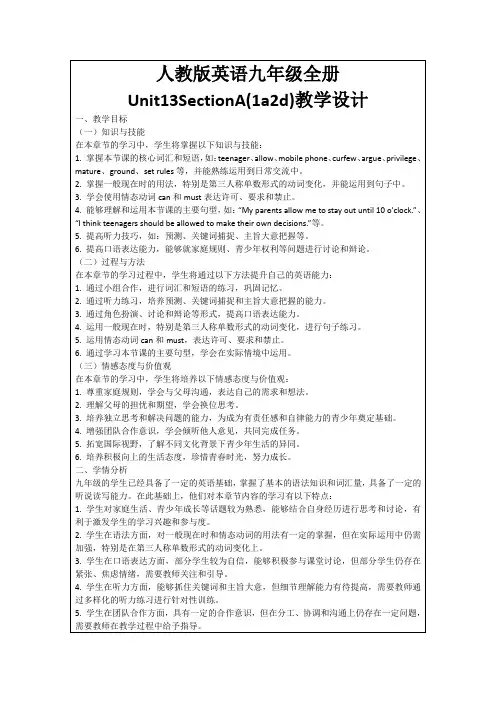
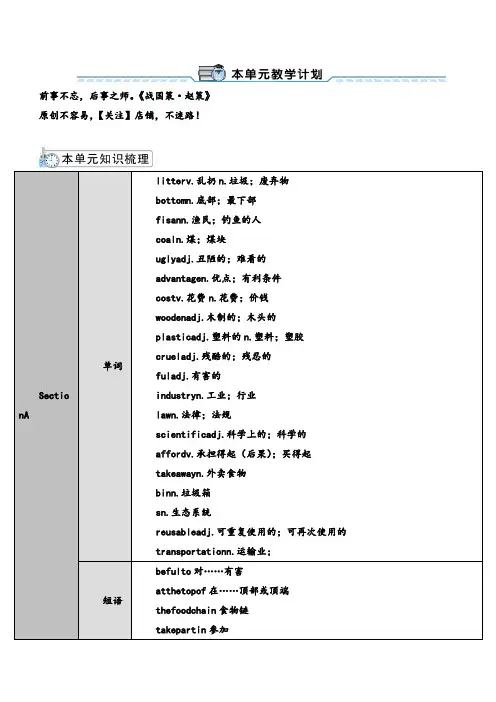
前事不忘,后事之师。
《战国策·赵策》原创不容易,【关注】店铺,不迷路!Sectio nA 单词litterv.乱扔n.垃圾;废弃物bottomn.底部;最下部fisann.渔民;钓鱼的人coaln.煤;煤块uglyadj.丑陋的;难看的advantagen.优点;有利条件costv.花费n.花费;价钱woodenadj.木制的;木头的plasticadj.塑料的n.塑料;塑胶crueladj.残酷的;残忍的fuladj.有害的industryn.工业;行业lawn.法律;法规scientificadj.科学上的;科学的affordv.承担得起(后果);买得起takeawayn.外卖食物binn.垃圾箱sn.生态系统reusableadj.可重复使用的;可再次使用的transportationn.运输业;短语befulto对……有害atthetopof在……顶部或顶端thefoodchain食物链takepartin参加句型1.Doyouofenthrowawaythingsyoudon'tneedanymore?你是否经常把你不再需要的东西扔掉呢?2.efromoldbuildingsaroundallsonline.她开了一家小店卖她制作的包,并且她还开了一家网店出售它们。
语法现在进行时;被动语态;现在完成时知识目标复习现在进行时、现在完成时和被动语态等的用法。
能力目标以“保护环境”为主题,运用本课相关句型与他人展开讨论;能向大家介绍有哪几种污染类型,怎样回收利用废弃物品等。
情感目标体会到保护环境重要性,学会保护大自然、保护地球,从身边的小事做起,号召大家参与到保护环境的行动中来。
【课时建议】本单元建议5课时SectionA(1a~2d)……………………………………………………………………………………1课时SectionA(3a~4c)……………………………………………………………………………………1课时SectionB(1a~1e)…………………………………………………………………………………1课时SectionB(2a~2e)…………………………………………………………………………………1课时SectionB(3a~3b)……………………………………………………………………………………1课时词汇短语:主要采用多媒体及图片展示法。
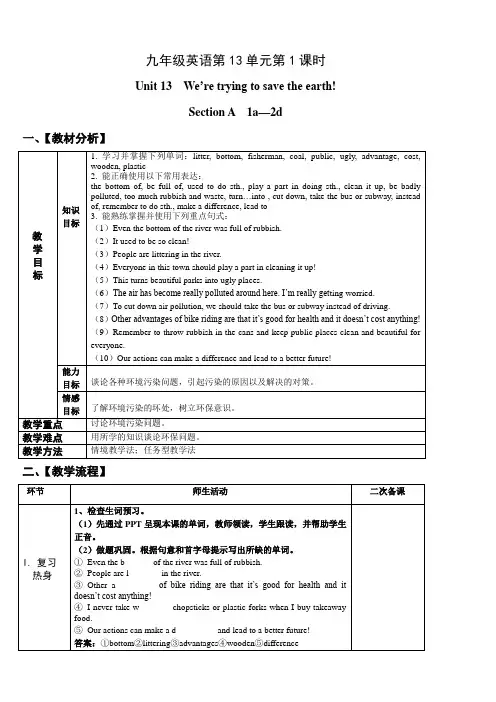
九年级英语第13单元第1课时Unit 13 We’re trying to save the earth!Section A 1a—2d一、【教材分析】二、【教学流程】2、自由交谈。
Talk about different kinds of pollution:Noise pollutionAir pollutionWater pollutionⅡ.感知体验感知1.PPT展示下列图片,引导学生初步感知种种污染问题。
体验1. 分组谈论图片展示的污染问题。
感知 2. 环境污染问题严重,如何保护地球呢?创设问题情景,引导学生思考环境保护的方法。
·You drink a can of cola. What do you do?·There are a lot of old newspapers at your home. What do you do?·You go shopping. What do you do?·When you write on a piece of paper, what do you do?体验2. 分四个小组分别讨论上述问题。
S1: I throw away cans.S2: I recycle cans.S3: You throw away th e cans. That’s bad for the Earth. You recycle the cans. That’s good for the Earth.Ⅲ.强化巩固1. 处理教材1a,1b,1c的内容。
(1)Here are some words related to different kinds of pollution. Write them in the box below. Then add more words.答案:Noise pollution:cars, factories, smoking, building houses (burning, power plants, nuclear waste disposal)Air pollution:Loud music, planes, building houses, mobile phones (machines, crowds)Water pollution:rubbish, littering, ships, factories (sewage, industrial waste, pesticides)(2) Listen and fill in the blanks. Then match the restaurants with the statements.①The river was _________. Even the bottom of the river was full of ________. There were no more _____ for fishmen to catch.②People are throwing _____into the river. Factories are putting _______ into the river.③We should write to the ________ and ask them to ___________ the factories. Everyone should help ________to the river.答案:①really dirty, rubbish, fish ②litter, waste ③government, close down,clean up(3) Role-play the conversation.—The river has always been the nicest river in this town.—Yes, it used to be so clean.三、【板书设计】四、【教学反思】。
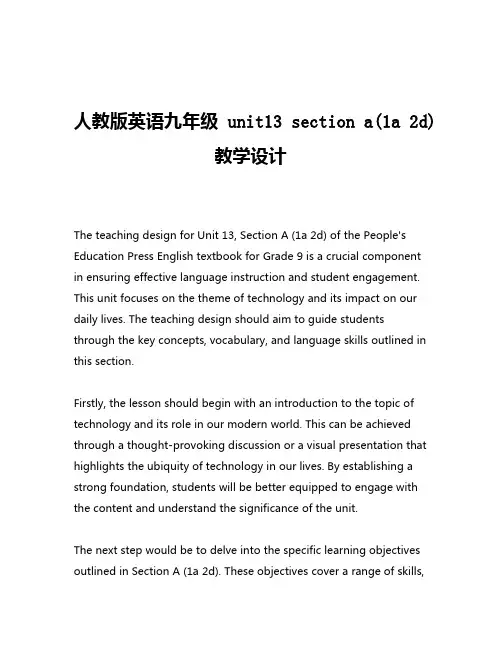
人教版英语九年级unit13 section a(1a 2d)教学设计The teaching design for Unit 13, Section A (1a 2d) of the People's Education Press English textbook for Grade 9 is a crucial component in ensuring effective language instruction and student engagement. This unit focuses on the theme of technology and its impact on our daily lives. The teaching design should aim to guide students through the key concepts, vocabulary, and language skills outlined in this section.Firstly, the lesson should begin with an introduction to the topic of technology and its role in our modern world. This can be achieved through a thought-provoking discussion or a visual presentation that highlights the ubiquity of technology in our lives. By establishing a strong foundation, students will be better equipped to engage with the content and understand the significance of the unit.The next step would be to delve into the specific learning objectives outlined in Section A (1a 2d). These objectives cover a range of skills,including reading comprehension, vocabulary development, and language structures. The teaching design should incorporate a variety of instructional strategies to address these objectives effectively.For the reading comprehension component, the teacher can begin by introducing the text and providing context to help students better understand the content. This could involve pre-reading activities, such as predicting the main ideas or discussing key vocabulary. During the reading process, the teacher should encourage students to actively engage with the text, asking questions and making connections to their own experiences.To enhance vocabulary development, the teacher can incorporate targeted activities that focus on the new words and phrases introduced in the unit. This may include word games, vocabulary puzzles, or even creative writing exercises that challenge students to use the new vocabulary in context. By providing ample opportunities for practice and reinforcement, students will be better equipped to retain and apply the new vocabulary.In terms of language structures, the teaching design should address the specific grammatical concepts and sentence patterns highlighted in the unit. This can be achieved through a combination of direct instruction, guided practice, and independent practice activities. Theteacher should ensure that students not only understand the rules but can also apply them effectively in their own writing and speaking.To further enhance the learning experience, the teaching design should incorporate a range of engaging and interactive activities. This may include group discussions, role-play scenarios, or multimedia presentations that allow students to explore the topic from different perspectives. By creating a dynamic and collaborative learning environment, the teacher can foster a deeper understanding of the content and encourage students to actively participate in the learning process.Moreover, the teaching design should incorporate opportunities for formative assessment throughout the lesson. This can involve informal checks for understanding, such as exit tickets or short quizzes, as well as more formal assessments, such as written assignments or oral presentations. By regularly assessing student progress, the teacher can identify areas of strength and weakness, and adjust the instructional strategies accordingly.Finally, the teaching design should include a summative assessment that evaluates the students' overall understanding of the unit's content and language skills. This may take the form of a comprehensive test or a project-based assessment that challenges students to apply their knowledge and skills in a real-world context.In conclusion, the teaching design for Unit 13, Section A (1a 2d) of the People's Education Press English textbook for Grade 9 should be a well-structured and comprehensive plan that addresses the key learning objectives, incorporates a variety of instructional strategies, and fosters a engaging and collaborative learning environment. By doing so, the teacher can effectively guide students through the content, develop their language skills, and prepare them for success in their future academic and personal endeavors.。
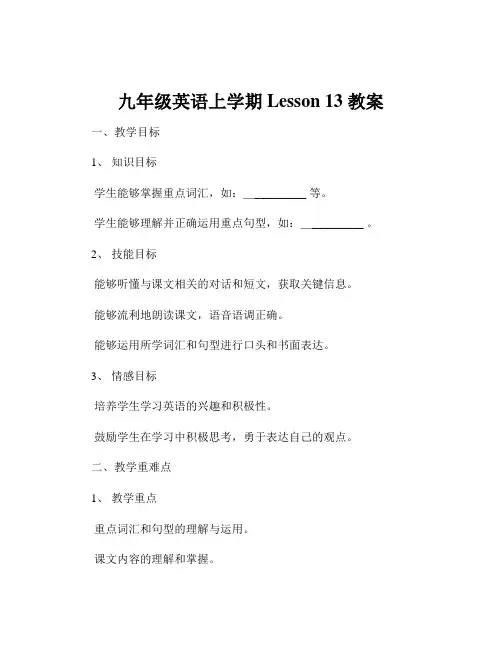
九年级英语上学期Lesson 13 教案一、教学目标1、知识目标学生能够掌握重点词汇,如:__________ 等。
学生能够理解并正确运用重点句型,如:__________ 。
2、技能目标能够听懂与课文相关的对话和短文,获取关键信息。
能够流利地朗读课文,语音语调正确。
能够运用所学词汇和句型进行口头和书面表达。
3、情感目标培养学生学习英语的兴趣和积极性。
鼓励学生在学习中积极思考,勇于表达自己的观点。
二、教学重难点1、教学重点重点词汇和句型的理解与运用。
课文内容的理解和掌握。
2、教学难点某些语法点的准确运用,如:__________ 。
如何引导学生将所学知识运用到实际情境中。
三、教学方法1、讲授法讲解重点词汇和句型,让学生理解其含义和用法。
2、练习法通过练习题巩固所学知识,加强学生对知识点的掌握。
3、情景教学法设置真实的语言环境,让学生在情境中运用所学知识。
4、小组合作学习法组织学生进行小组讨论和合作,培养学生的团队合作能力和语言交流能力。
四、教学过程1、导入(Warming up)通过播放一段与本课主题相关的英语视频或展示一些图片,引起学生的兴趣,导入新课。
提出一些与视频或图片相关的问题,引导学生思考和讨论,如:What can you see in the pictures / video? What do you think of it? 等。
2、词汇学习(Vocabulary)展示本课的重点词汇,带领学生朗读并讲解其含义和用法。
可以通过举例、造句等方式帮助学生理解和记忆词汇。
进行词汇练习,如填空、选择等,检查学生的掌握情况。
3、句型学习(Sentence Patterns)呈现重点句型,讲解句型的结构和用法。
引导学生模仿句型进行造句练习,鼓励学生积极发言。
4、课文学习(Text Learning)让学生听课文录音,理解课文大意。
逐段讲解课文,解释重点短语和句子,帮助学生理解课文内容。
组织学生进行分角色朗读或复述课文,锻炼学生的口语表达能力。
Unit 13 We’re trying to save the earth!Period 1 Section A 1a-2d【知识与能力目标】1.掌握重点单词及短语。
2.复习语法:能正确区分和使用以下语法结构:现在进行时,现在完成时,被动语态,情态动词和used to 句型。
【过程与方法目标】本课主要采用任务型教学法,情景教学法以及多媒体辅助教学,充分发挥教师的主导作用和学生的主体地位。
利用现代化教育技术优化教学过程,通过课件为学生创设更多生动活泼的语言环境,把学生吸引到活动中去,并激发他们主动参与学习的欲望,努力培养学生自主学习的能力。
【情感态度价值观目标】通过学习具有环境危机意识,学会关注环境保护环境。
【教学重点】(1)能正确运用现在进行时,现在完成时,被动语态,情态动词和used to 句型。
(2)保护环境的措施方法。
【教学难点】能正确运用现在进行时,现在完成时,被动语态,情态动词和used to 句型。
【教学步骤】Step 1. PresentationShow the picture of the earth and tell students the earth is polluted now.For example: (1) The factories that burn coal pollute the air with a lot of black smoke.(2) Factories put waste into the river.(3) People should throw away litter in the bin.(4)There are more cars on the road.Learn some new words.Step 2. Work on 1aHere are some words related to different kinds of pollution. Write them in the box below. Then add more words.loud music cars rubbish planes littering ships factories smoking building houses mobile phonesnoise pollution air pollution water pollution____________ ___________ _________________________ ___________ _________________________ ___________ _________________________ ___________ _____________Step 3. Listening1. Work on1b. Listen and complete the sentences.What was the problem?The river was _____________. Even the bottom (底部) of the river was full of ________. There were no more ______ for fishermen (渔民) to catch.What caused the problem?People are throwing _______ into the river. Factories are putting ______ into the river.How should the problem be solved?We should write to the ____________ and ask them to ___________ the factories. Everyone should help to __________ the river.2. Listen again and answer the following questions.1)What does Tony want to do later this afternoon?He wants to go swimming with Mark in the river later this afternoon.2) Why doesn’t Mark want to go with Tony?Because the river was really dirty. Even the bottom of the river was full of rubbish, and there were no more fish for fishermen to catch.3) How was the river in the past?It used to be so clean. It has been the nicest river in this town.Step 4. Practice1. Role-play the conversation in 1c.Mark: The river was dirty. Even the bottom of the river was full of rubbish.Tony: But it used to be so clean!Mark: Yes, but people are throwing litter into the river.Tony: Everyone in this town should play a part in cleaning it up!2. Make conversations using the pollution in 1a.A: The river has always been the nicest river in this town.B: Yes, it used to be so clean.A: But I was there last weekend and the river was really dirty.B: What caused the problem?A: People are throwing litter into the river.B: What should we do?A: Factories are also putting waste into the river.B: Yes, everyone in this town should play a part.A: We should write to the government and ask them to close down the factories.B: What else can we do?A: Everyone should help to clean up the river.Step 5. Language points1. We’re trying to save the earth! 我们正在竭尽全力拯救地球!try to do =try one’s best to do 努力去做某事。
e.g. We’ll try to finish the work in a week. 我们将努力在一周内完成这项工作。
2. Here are some words related to different kinds of pollution.be related to 与…有关e.g. Is the driver relate to the accident?司机和这起事故有关吗?3. .Even the bottom of the river was full of rubbish.Yes, but people are throwing litter into the river.litter 和rubbish 都可指“垃圾”,用作不可数名词。
rubbish 指“没用的东西(被扔或将要丢弃的无用的东西)”不可回收。
litter 指“(室内或公共场所)乱扔的废物(纸屑、不要的包装纸、废瓶等)”还可回收e.g. Throw the rubbish out. 把垃圾扔出去。
The room is full of rubbish. 房间里堆满了垃圾。
Pick up your litter after a picnic. 野餐后将废弃物收拾好。
Step 6. Listening1. Work on 2a. Listen to the interview. Circle the kinds of pollution that Jason and Susan talk about.A. land pollutionB. air pollutionC. noise pollutionD. water pollution2. Work on 2b. Listen again and complete the sentences.1) The air is badly polluted because there are ___________ on the road these days.2) Factories that burn coal also ________ the air with a lot of black smoke.3) There is also too much rubbish and waste. People _________________ things every day.4) People are also littering in ______________ like parks. This is turning beautiful places into ugly (丑陋) ones. Step 7. Practice (Work on 2c)Use the information in 2a and 2b to role-play conversations between Jason and Susan.Jason: The air has become really polluted around here. I’m getting very worried.Susan: Yes, I used to be able to see stars in the sky.Jason: The problem is that…Step 8. DiscussionAsk students what we should do to save the earth. Help students answer, turn off thelights when you leave a room; stop riding in cars; stop using paper towels or napkins; recycle books and paper. Step 9. Reading1. Read 2d and complete the chart.Problems Solving problemsair pollutionwaste pollutionwooden (木头的) chopsticks or plastic forksrubbish2. Role-play the conversation.Interviewer: Jason and Susan, what are your ideas for solving these problems?Jason: Well, to cut down air pollution, we should take the bus or subway instead of driving.Susan: Yeah, or ride a bike. There are other advantages (优点) of bike riding. It’s good for health and it doesn’t cost (花费) anything!Interviewer: Great ideas! What about waste pollution?Susan: Mmm, I think simple things like bringing a bag to go shopping can help. I started doing that a year ago. Jason: Me, too. Also, I never take wooden chopsticks or plastic (塑料) forks when I buy takeaway (外卖食品) food.I use the ones at home.Susan: And remember to throw rubbish in the bins and keep public places clean and beautiful for everyone. Interviewer: So together, our actions can make a difference and lead to a better future!Step 10. Language points1. It’s good for health and it doesn’t cost anything!cost v. 花费;使付出指花费金钱,主语通常是物。